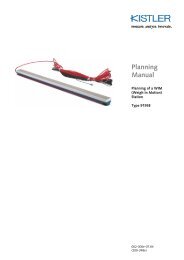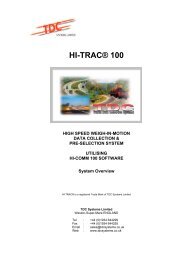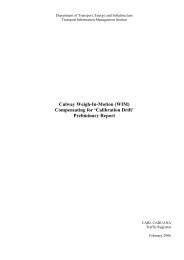You also want an ePaper? Increase the reach of your titles
YUMPU automatically turns print PDFs into web optimized ePapers that Google loves.
UDefinition<br />
MAIN ROADS Western Australia<br />
<strong>Guide</strong> <strong>to</strong> the <strong>Design</strong> <strong>of</strong> <strong>Culway</strong>.doc<br />
Appendix A<br />
Pentagon Systems<br />
Procedure for <strong>Culway</strong> MSA Strain Gauge Installation<br />
This information note has been produced <strong>to</strong> describe a technique used by Pentagon<br />
Systems for many years as a method for repeatable and proper strain gauge placement.<br />
Strain gauges are used <strong>to</strong> measure the strain on the underside ro<strong>of</strong> <strong>of</strong> a culvert as a<br />
vehicle pass over.<br />
The strain transducer and matched buffer amplifier assemblies are calibrated by ARRB<br />
by applying known mechanical strains <strong>to</strong> the transducer and then adjusting the buffer<br />
amplifier gain <strong>to</strong> obtain a correct electrical output. These matched assemblies are then<br />
issued with a calibration certificate. In-field calibration <strong>of</strong> a buffer is possible (refer <strong>to</strong><br />
ATM 22).<br />
The strain transducers are machined from mild steel. In operation a displacement<br />
measured over the 300mm length <strong>of</strong> the gauge is focused on the 30mm ring. This<br />
produces a mechanical amplification <strong>of</strong> about 10.<br />
UHandling<br />
Strain transducers or MSA’s are highly sensitive calibrated pieces <strong>of</strong> equipment that<br />
must be handled with extreme care <strong>to</strong> ensure accurate continued operation.<br />
MSA’s should always be picked up from the centre ring and never from the ends as their<br />
own weight could cause permanent deformation. Padded instrument suitcases should<br />
always be used when s<strong>to</strong>ring and transporting gauges <strong>to</strong> site. Gauges should never be<br />
dropped or have external pressure applied <strong>to</strong> them as damage could result. Any<br />
permanent deformation <strong>to</strong> the gauge will result in an electrical output <strong>of</strong>fset that in some<br />
causes cannot be balanced out with the associated buffer amplifier. The transducer or<br />
MSA in these circumstances must be either repaired or replaced.<br />
UInstallation<br />
This technical note does not cover details in regards <strong>to</strong> placement <strong>of</strong> MSA’s as this<br />
varies with each site. This document however attempts <strong>to</strong> explain a tried and proven<br />
procedure which is repeatable for securing gauges <strong>to</strong> the ro<strong>of</strong> <strong>of</strong> the culvert.<br />
Poorly mounted and secured gauges can cause a number <strong>of</strong> problems in relation <strong>to</strong> site<br />
calibration, site drift and maintaining a consistent performance from the site. Gauges<br />
which are mounted or secured with some element <strong>of</strong> deformation due <strong>to</strong> the method they<br />
were secured or the fixing points can produce inconsistent outputs when put <strong>to</strong> work.<br />
The gauges, by design have been calibrated <strong>to</strong> operate within a range. When attempts<br />
are made <strong>to</strong> operate these gauges outside this range, erroneous results can lead <strong>to</strong> the<br />
problems that have been identified previously.<br />
Before any gauge is secured <strong>to</strong> the ro<strong>of</strong> <strong>of</strong> the culvert the following precautions should<br />
be made <strong>to</strong> ensure the gauge is not damaged and that it can operate in a not deformed<br />
or pre-stressed state.<br />
• The use <strong>of</strong> a gauge template (a steel bar which is dimensionally identical <strong>to</strong> the<br />
Page 12
















